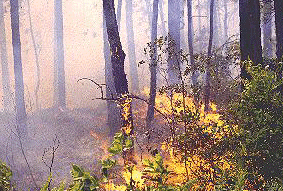

Virginia Department of Conservation and RecreationAn official website of the Commonwealth of Virginia Here's how you knowAn official websiteHere's how you know

Virginia Department of Conservation and RecreationAn official website of the Commonwealth of Virginia Here's how you knowAn official websiteHere's how you know
 Department of Conservation and Recreation
Department of Conservation and Recreation

Whether caused by lightning or by the hand of man, fire has been a part of the natural world for centuries. In Virginia, prior to European settlement, American Indians set fires intentionally for hunting, protection, warfare, agriculture, vegetation management, and food gathering. On flat terrain, fires would burn over large areas until some natural barrier or rainfall event was encountered. Today, unrestrained fire represents a hazard to public safety and property, but the benefits of carefully prescribed and controlled fire can still be realized. Fire is recognized as a cost-effective land management tool by silviculturalists, wildlife managers, and natural area managers. Prescribed burning is practiced today using skillful methods and rigid safety specifications.
Prescribed burning is the intentional use of fire in a particular time and place, under established conditions and specifications, to accomplish a biological or resource management goal. The Virginia Department of Conservation and Recreation uses prescribed burning when this practice benefits particular fire-dependent natural communities and species. Secondary benefits derived from regular burning include opening aesthetically pleasing landscapes, impressive displays of wildflowers, greater numbers and enhanced visibility of wildlife, and a profusion of blueberries, huckleberries, and raspberries.
Vegetation succession is the natural process by which one type of vegetation is replaced by another leading toward increased biomass and altered vegetation structure. The theoretical "end point" of succession is referred to as the climax, or steady-state condition in which the community is more or less self-sustaining. Throughout much of Virginia, succession left unchecked would result in dense, closed canopy forest. Maintaining open, early-successional types of vegetation such as prairie, savanna, woodland and glade, and the species dependent on these communities, necessitates fire management as a means of "setting back" the process of succession.
Fire contributes to maintaining Virginia's natural heritage in many ways. Entire forest types such as longleaf pine forest, pitch pine forest, and table mountain pine forest are created and perpetuated by fire. The grassy savannas created by fire provide the necessary breeding habitat for rare Bachman's Sparrows and other forms of wildlife. Prairie vegetation still exists in Virginia largely because of frequent accidental fires along railroad tracks. Lastly, there are over 100 rare plant species which either depend on or benefit from fire. Fire liberates the rare plants from competing woody vegetation and sometimes enhances seed germination. The case of the Virginia endemic, Peter's Mountain Mallow, is dramatically illustrative. Just four naturally established individual plants remained until an experimental burn was conducted at the site. Four hundred new plants appeared after the fire! Using prescribed fire management has effectively rescued this species from the brink of extinction.

